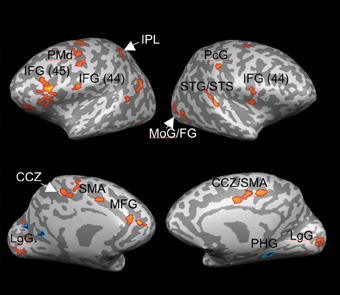The motions involved in writing, waving goodbye or turning a jumprope all obey the same law of movement. As far back as the 19th century, observers noted that sharper curves are tackled at lower speeds. Anyone thinking of violating this law should think again: Experiments have shown it is nearly impossible to force healthy subjects to generate arm movements that do not conform to this law, today known as the 2/3 power law of motion.
Why do the body’s movements comply with the power law? Some have argued that these forms of body movement are simply a byproduct of muscular action. Recent experiments, however, have shown that not only does the 2/3 power law constrain movement generation, it also comes into play when we visually perceive motion. In one such experiment, volunteers were asked to observe a dot on a computer screen that rotated around an ellipse according to one of three scenarios: 1: the dot travels around the ellipse at constant speed; 2: the dot speeds up at the straighter segments of the ellipse, and slows down as it rounds the bend; 3: the dot slows down in the straighter segment of the ellipse and speeds up at the bend. Contrary to intuition, the dot that appeared to the subjects to move more uniformly was not the first dot, which actually moves at a constant speed, but rather the second dot – the one that obeys the 2/3 power law.
Until now, there was little evidence to suggest neural underpinnings to the 2/3 power law, and no one had been able to identify the brain areas that may be involved. Ph.D. student Eran Dayan and Prof. Tamar Flash of the Weizmann Institute’s Computer Science and Applied Mathematics Department, Nava Levit-Binnun of the Institute’s Physics of Complex Systems Department, and Dr. Talma Hendler of the Tel Aviv Sourasky Medical Center, Israel, in collaboration with Antonino Casile and Martin Giese of the Hertie Institute for Clinical Brain Research, Tubingen, Germany, have identified, for the first time, specific brain regions that are selectively activated in response to motion that obeys the 2/3 power law. These findings suggest that the body’s 2/3 power law of motion is controlled by neural mechanisms arising in the brain, as opposed to being a by-product of muscular action. The implication is that such trajectories are planned in detail in the brain prior to their execution. Their findings have recently been published in the journal Proceedings of the National Academy of Sciences (PNAS), USA.
In a variation on the original behavioral experiment, the team asked volunteers to observe a cloud of dots rotating around an ellipse according to the same three scenarios while fixing their eyes on a point in the middle of the ellipse. During some experiments, their eye movements were also monitored using special equipment, to eliminate the possibility that the eye movements themselves accounted for the observed results. With the help of functional magnetic resonance imaging, the scientists mapped the areas of the brain that were activated during the task. The results show that different areas of the brain are activated according to the type of motion the volunteers observe. The regions that respond to the 2/3 power law of motion are those that subserve the generation of movement, visual motion processing and action observation. The activation of these areas in response to the 2/3 power law of motion is much stronger than the response to any other form of motion.
Why does the brain seem to prefer the 2/3 power law of motion? And why do separate neuronal networks exist for different types of motion? Apart from the idea that the law keeps movement smooth, Flash and her colleagues have come up with a new theory: It all boils down to underlying geometrical features.
“After conducting various mathematical and geometrical analyses, we suggest that different areas of the brain seem to be using distinct geometries that take into account such features as curvature or straight lines, and this is why we see different brain areas responding to and generating different types of motion perception and action.”
A number of recent brain studies have found a strong coupling between perception and action: Seeing movement can activate the same brain areas as those activated by the physical act itself. Scientists have theorized that this dual activation helps us to learn by imitation as well as to understand the actions of others. The new findings show that this coupling extends to the most basic aspects of motion, and they identify the precise laws that govern the very flow of our movements. They suggest, says Flash, any number of future lines of research into how the brain is organized to control and perceive movement, as well as how possible impairments in these processes may be involved in neurological diseases.

Prof. Tamar Flash’s research is supported by the Manfred D. Moross Laboratory for Vision Research and Robotics; and Sylvia and Henry Legrain, Spain. Prof. Flash is the incumbent of the Dr. Hymie Moross Professorial Chair.
 Prof. Tamar Flash%2C Dr. Talma Hendler and Eran Dayan. Setting the speed limit.jpg)
